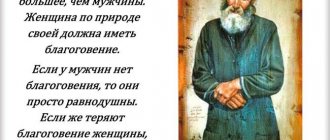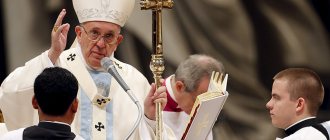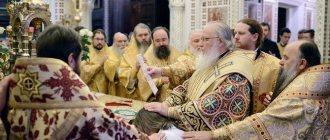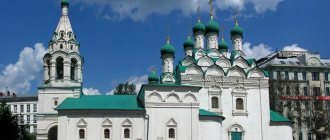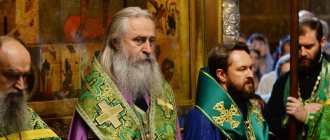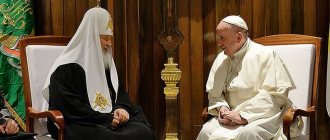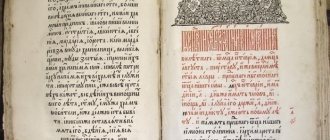A presbyter, or Catholic priest, refers to the second degree of priesthood, and there are three of them - deacon, priest, bishop. Only the bishop has the right to carry out elevation to rank, or ordination, to all three degrees.
This rite belongs to the sacraments of the church, but is performed only by laying the hands of the bishop on the head of the initiate and praying for the descent of the Holy Spirit on him. In this rite there is no secret formula inherent in other sacraments. Before the rite of ordination itself, the initiate prostrates himself before the altar, depicting a cross as a sign of humility, reverence and dedication of his entire life to Christ.
Knowledge is the best weapon
Before being ordained, a Catholic priest studies a lot. The Roman Catholic Church has always attached great importance to education - the first theological universities arose in the Middle Ages. In Europe, a mandatory condition for ordination to the first rank is four years of study. And when entering the priesthood, the candidate is required to study at the Higher Theological Seminary for at least 4 years. In Russia, in St. Petersburg, there is the only Higher Theological Seminary in the country, called “Mary - Mother of the Apostles” and training Catholic priests. The duration of study is 6 years. In Novosibirsk there is a pre-seminary that prepares candidates for admission to the Higher Academy.
How do you become a Catholic priest?
When we choose a future profession, we most often think about its demand in the labor market. Sometimes we follow our dreams or family traditions. How does a person decide to devote his life to serving God?
Behind the massive gates is another life. With its own rules and laws. I don’t immediately dare to enter. It seems that I don’t fully understand where I’m going and how I should behave, much less what to talk about. I had to think long and hard about what to wear. But still I cross the threshold. And I find myself in a quiet, well-kept courtyard with many flowers.
I am greeted by a young man in a long black robe. In hot weather, this is the first thing that catches your eye. In a benevolent smile and a slightly questioning look I read: “What destinies?” It is clear that girls do not come here every day, so I immediately explain the purpose of the visit. Light yellow and white walls, a stand with awards and photographs, a steep staircase... Climbing it in heels is already a challenge. Finally we find ourselves in one of the rooms. I like everything here - a large window, a sofa, a “homey” table and a cup of aromatic coffee with sweets. This is how guests are greeted here.
Study and Prayer
Young priests study at the Grodno Theological Seminary for six years. Like ordinary students, they take the session: in winter and spring. They are also “tormented” during exams, and may be expelled for poor performance. They undergo internships in parishes of the diocese and participate in pilgrimages.
During their years of study, clergy (as students are called here) study philosophy, theology, psychology, ethics, sacred music, foreign languages (Latin, Greek, English, Italian, Polish), and special subjects. They spend a lot of time reading prayers, studying the Holy Scriptures, the lives of saints, and the works of the church fathers. The day of future priests begins at half past six in the morning. Morning prayer. Then they have breakfast and by 9 o’clock they go to classes - about five pairs, each for 45 minutes. After lunch there are two hours of free time. Clerics have the opportunity to engage in sports. The seminary has its own football team, whose players are proud of their victories. A music group has been organized that has released more than one disc. At six in the evening there is another prayer - before dinner, and at half past ten - another one, evening. They go to bed around eleven o'clock in the evening.
Not everyone has it
According to Father Jan Radyuk, being a priest is not a profession. In construction or any other industry, people make choices. Here everything is connected with vocation. And only God gives it.
— As Blessed Pope John Paul II said: “A calling is a gift and a mystery. The gift that God gives us, and the mystery that man touches,” says Father Jan.
But how can you feel this power within yourself, how can you understand that this is your path, and not miss the sign of fate? According to Father Ian, lightning does not strike from the sky - everything is much simpler. At some point a person realizes that he is needed here...
“Every Sunday from the age of eight I went to church with my parents,” says the priest. “Over time, I began to understand that this was my path. It is difficult to pinpoint a specific moment when I felt the voice of God's calling. It all comes on its own, at the right time.
Willpower equals faith
Denis Brazinsky is one of the seminarians. He is a fourth-year student, and before embarking on the path of faith, he told everyone that he would go to a circus school. So that they don’t pester you with questions or advice. This choice is a very personal matter.
“I didn’t tell anyone where I was going to study,” says Denis. - Neither teachers, nor friends. I was unhappy with people's reactions after they found out about my plans. When I entered in 2009, there were 14 people in the first year, today there are only 6 left. Many leave - they can’t stand it. By the way, after completing the first year of study, a student can take an academic leave. For a whole year he lives at home, communicates with friends. During this time, he must decide, understand and choose the right path.
Studying at the seminary is not exactly life behind a high fence. Students can walk around the city twice a week. As for the guests, they are happy to see them here every day. True, you have to call family and friends from a payphone; you won’t find a cell phone in the pocket of a future priest. But as an alternative, the computer class has the Internet. For the first two years, seminary students wear ordinary suits brought from home, but starting from the third they wear a cassock. Clerics have a negative attitude towards alcohol, but here it is simply prohibited. As for smoking, there are concessions. There is a special place for this on the seminary grounds. As Father Ian explained, it is difficult to prohibit a person from smoking when he is addicted. But at the seminary everything is done to help young people get rid of their bad habit.
First things first - airplanes
Frankly, I couldn’t help but ask my main question: what about walks under the moon with girls? What about calls five times a day and SMS at night? It’s probably hard for me to understand, especially when you see a handsome young man in front of you.
“Yes, I had a girlfriend before entering the seminary,” Denis admits. - But here it is important to understand something else: you choose this path, which means you accept everything that it brings with you. You must come to terms with it and understand whether your choice is conscious. If you are firm in your decision, everything comes much easier.
I won’t lie, it’s difficult for an ordinary person to understand and accept this. Moreover, you are immersed in life here for only two hours. But you understand one thing for sure: priests are strong people...
Maturity test
Grodno Higher Theological Seminary was founded in 1990 by Archbishop Tadeusz Kondrusiewicz. Over the 22 years of its existence, it has produced more than two hundred priests who work in the dioceses of Belarus, Russia, Ukraine and Kazakhstan. The seminary has the status of a higher educational institution, but the procedure for admission here is somewhat simpler than at a regular university. Applicants must personally submit documents, and the list includes not only a certificate, military ID, medical certificate, but also baptismal certificates, parents’ wedding certificates, as well as a reference from the rector of the local parish. Then the applicant takes an exam in the form of testing, which includes basic questions of the Catechism, the teachings of the Catholic Church and Holy Scripture. This test allows a person to figure out whether he has arrived there. Moreover, the tasks consist of questions to which a believer should know the answers.
According to Father Ian, it is impossible to say exactly what the “annual enrollment plan” for seminary students is. It could be three students or twenty. After all, no one can know exactly how many young people will hear the voice from above.
Features of the rank of a Catholic priest
A Catholic priest has the right to perform five of the seven sacraments. The exceptions are the sacraments of priesthood and anointing. And the sacrament of confession can be performed even by a presbyter removed from worship. The important fact is that an Orthodox priest can be excommunicated from the church, and he turns into a defrocked priest. And a legally ordained priest of the Catholic Church cannot be deposed by anyone and never - upon ordination he receives the “indelible seal of the priesthood.” As in Orthodoxy, Catholic clergy are divided into black (monastic) and white (diocesan) clergy. It is customary to address the presbyter as “Father Imyarek.” There is such a thing as a Catholic parish priest. It is clear that such a presbyter must have a parish or he must be the rector of an abbey. In France, such priests are called curés.
Expert: Celibacy is a long-standing Catholic tradition, but not a doctrine
Answered by an expert in the field of canon law, Catholic priest Dmitry Pukhalsky: Although Catholic priests are prohibited from marrying, there are also married priests in the Catholic Church. What's the matter? Speaking about celibacy, we must remember that this is a voluntary refusal to marry. Therefore, it is more correct to say not that Catholic priests are forbidden to marry, but that the Catholic Church ordains men who have chosen a life of celibacy as priests (there are several exceptions, which will be discussed in more detail below). It should be recalled that, firstly, in both the Catholic and Orthodox churches you cannot marry while already a priest, and, secondly, celibacy is mandatory for those who have chosen monastic service. Consider, however, situations where a Catholic priest may be married. The first of these is that he is not a priest of the Latin rite. As you may know, in addition to the Latin Rite (with which most people associate Catholicism), there are Churches of the Eastern Rites that are in full communion with the Holy See (today there are 23 of them). There are married priests there, since celibacy is not mandatory for them (but, again, you can never marry after taking holy orders!). By the way, the priests of these churches can also serve in the Latin rite. The next situation when the appearance of married clergy is possible - already in the Catholic Church of the Latin Rite - is the reunion of Anglican priests with it. According to the Apostolic Constitution Anglicanorum coetibus of 15 January 2011, the ordination of former Anglican married priests as priests of the Latin Rite is permitted subject to certain conditions. It is important to remember that celibacy is only a tradition; it has no doctrinal justification. In the first centuries of Christianity, communities did not require celibacy from priests, but part of the clergy even then voluntarily chose the path of celibacy. Celibacy became mandatory for priests during the reign of Pope Gregory VII only in the 11th century. What will happen to a priest if he gets married during his ministry? According to Canon 1394 of the Code of Canon Law, a priest who attempts to contract a marriage is subject to ecclesiastical punishment (“suspension”), which results in a ban on ministry. The punishment is "automatic", that is, a direct and immediate consequence of the priest's attempt to consummate the marriage. If a person who has left the priestly ministry wants to marry his wife in the Catholic Church and participate in the sacraments, then this requires release (dispensation) from celibacy, the provision of which remains the exclusive prerogative of the Pope.
Features of the priest's clothing
Outwardly, a Catholic priest is always recognizable by the robe consisting of a cassock (a long outer garment with long sleeves), worn outside of services. It has a stand-up collar, into which the most important distinctive feature of the Western clergy is inserted - the colorator, or Roman collar. This is a hard white insert, which used to be solid and wrapped around the neck, representing a collar and thus denoting a devoted servant of God. The robe of a Catholic priest comes in different colors, which indicate the degree of cleric.
Catholic priest, his rights and duties
A Catholic priest is a minister of the Catholic cult. In Catholicism, as in the Orthodox Church, priests belong to the second degree of priesthood. The basis of church cult are visible manifestations of God's grace - the sacraments, which are the names of the actions established by Jesus Christ for the beneficial salvation of people. The symbolism of the sacraments helps believers understand God's love for man. According to church teaching, by participating in the sacraments, a person receives miraculous help from above.
The Catholic Church, like the Orthodox Church, allows seven sacraments: baptism, confirmation (confirmation), Eucharist, anointing, penance, marriage and priesthood. A priest of the Orthodox and Catholic churches has the authority to perform five sacraments, in addition to priesthood (ordination) and confirmation (this requires special permission from the bishop of the diocese in which the minister is incardinated). Ordination to Catholic ministers occurs through the ordination of a bishop.
A Catholic priest can be a member of the black or white clergy. Black clergy implies monasticism - in accordance with the vow of an ascetic lifestyle surrounded by a monastic community (or in hermitage). The white clergy is a ministry within the territory of the diocese. According to the totality of liturgical customs in the Latin Catholic rite, the obligatory rule for all priests is celibacy - a vow of celibacy. Celibacy regards the liturgical rites of the Eastern Catholic Church as mandatory rules only for monastic priests, as well as bishops.
According to church traditions of the Catholic clergy, the robe of a Catholic priest is a cassock, a long outer garment with long sleeves that the minister must wear outside of worship. The cassock is fastened with a row of buttons, has a stand-up collar and a length reaching to the heels. Color is determined according to hierarchical position. The priest's cassock should be black, the bishop's cassock should be purple, the cardinal's cassock should be purple, and the pope's cassock should be white.
During the liturgy, a Catholic priest must be dressed in a white alba, ornat and stola. Alba is a long robe of Catholic and Lutheran clergy, which they girdle with rope. Alba is sewn from fine wool, cotton or linen. Ornat (casula) is a symbolically embroidered cloak of a priest, which is his main attire during the liturgy. Stola is a silk ribbon up to 2 meters long and up to 10 centimeters wide, with crosses sewn on it. Crosses on the table should be located at its ends and in the center.
The Catholic priest, the Pope, also wears a rocceta - a white pleated short robe trimmed with lace. This piece of clothing looks like a shirt with narrow knee-length sleeves. The rocceta is worn over the cassock. The Pope, cardinals, bishops and abbots also wear mozzeta - a short cape with a hood. Mozzetta should be worn with a cassock. Its color depends on the rank of the priest; bishops wear purple, cardinals wear scarlet. The Pope wears a variety of mozzetta, one in satin and the other in dark red velvet, adorned with ermine fur.
Liturgical vestment
The attire for the liturgy, the main Christian service, looks completely different. Its most important detail is the alba - a long white garment made of thin fabrics: linen, cotton or wool, belted with rope. Its prototype was an ancient Roman shirt worn under a tunic. A casula (cloak) or ornate is worn on the alba. This is an embroidered robe, similar to the deacons' cloak - dalmatica, but without sleeves. The next element of the presbyter’s clothing is the table, which is a two-meter ribbon, 5 to 10 cm wide, decorated at the edges and in the middle with crosses. It is worn around the neck over the ornate.
In general, in the Roman Catholic Church there are three types of church vestments - liturgical, for attending worship, and ceremonial. There are many more details in the liturgical clothing of the priest, such as the maniple, which is worn on the left hand (obviously, the word “manipulate” comes from it).
In Orthodoxy, the rank of abbot corresponds to the rank of abbot
If a Catholic abbot has the rank of abbot, then the abbot of a monastery in Orthodoxy bears the rank of abbot. In a number of local churches, including the Russian Church until 2011, it is also used as a hierarchical reward.
Initially, the abbot was not necessarily a priest; later they began to be elected only from among the hieromonks or to ordain a monk chosen by the abbot as a presbyter.
The brethren of the Holy Dormition Monastery in the city of Alexandrov with Abbot Seraphim (Semiletov). In Orthodoxy, the rank of abbot corresponds to the Catholic rank of abbot. Photo: 151722.selcdn.ru
In 1764, during the secularization reform, Russian monasteries were divided into three classes; the head of the monastery of the third, lower class began to be called abbot.
The difference between him and the archimandrite (the abbot of a monastery of the first or second class) was that during divine services he dresses in a simple monastic robe and gait.
While the archimandrite dresses in a mantle with “tablets”, a pectoral cross, a club and a miter. Catholics do not divide the abbot into classes.
Abbot
this is the abbot of the monastery of the 3rd, lowest class
Due to the fact that the total number of monasteries was greatly reduced, the rank of abbot became a reward for the monastic clergy. His rank corresponded to that of an archpriest in the white clergy and was not necessarily associated with the management of the monastery. This practice took hold in the 20th century, when after the revolution all monasteries in the USSR were closed.
It expanded after the Great Patriotic War, when a small number of them were active. Moreover, only the abbot, who was the head of the monastery, had the right to carry a staff.
Abbot's staffs. The abbot's staff can only be worn by the abbot who runs the monastery. Photo: rezba33.ru
In 2011, the Council of Bishops of the Russian Orthodox Church, having accepted the proposal of Patriarch Kirill, henceforth abolished the rank of abbot as a hierarchical award and decided to ordain not only hieromonks, but also archimandrites and even bishops as abbots if they take over the management of the monastery.
Simultaneously with the rank of abbot, the staff must be presented. When leaving the position of abbot (vicar) of the monastery, the title of hegumen will be retained by the person in memory of the labors incurred
Who is a Catholic priest?
You're a little confused.
How is Catholicism different from Orthodoxy?
It is precisely the Catholic Church that teaches that the Holy Spirit proceeds from the Father and the Son. The official teaching of the Orthodox Church does not contradict this, however, many Photians argue that the Orthodox Church teaches that the Holy Spirit proceeds [only] from the Father
Orthodoxy allows divorce not “occasionally”, but very often, one might say constantly
Orthodox theologians also recognize the primacy of the Pope in the Church. The only difference is in the understanding of the scope of his powers; the Orthodox believe that the primacy of the Pope is 1) honorary, not real, 2) a product of human tradition, not a divine institution, 3) lost due to the schism of 1054
Orthodox Christians are baptized in different ways, Catholics are also baptized differently depending on the rite
As a rule, only children are baptized by immersion in Orthodoxy. Both the Orthodox and Catholic Churches recognize and practice baptism by both sprinkling and immersion
3 3 · Good answer
How do Baptists, Protestants, Catholics and Orthodox Christians differ from each other in their concepts?
And Baptists are Protestants.
What will happen if I, a baptized Orthodox Christian, pray in a Catholic Church?
They tell this story. “One pilgrim came to the temple, but kept bowing in the wrong direction. Well-wishers noticed this and called the priest to shame him. The priest came and pointed out to the pilgrim his mistake: “In our temple we are supposed to bow in this direction.” And the pilgrim said: “I bow to God and I don’t know a side where He is not.”
5 2 · Good answer
Are Armenians Christians or Catholics?
1 5 · Good answer
Do you need to become a Catholic if you feel much more comfortable in the Catholic Church?
In the Roman Catholic Church, a parish (Latin: parochus) is a stable community of believers within a particular church, whose pastoral care has been entrusted to the parish priest (Latin: pastor) under the direction of the diocesan bishop. It is the lowest ecclesiastical division in the Catholic episcopal state and the main constituent of the diocese. In the 1983 Code of Canon Laws, parishes are constituted according to cc. 515-552, entitled "Parishes, Pastors and Parish Vicars."
Types Most parishes are territorial parishes, which comprise all Christian believers living in a specific geographic area. Some parishes may be combined with others in a deanery or vicariate forane and under the supervision of a vicar forane, also known as a dean or archpriest.
According to canon 518, a bishop may also erect non-territorial parishes or personal parishes within the limits of his vision. Personal parishes are created to better serve Catholics of the particular rite, language, nationality, or other identity that makes them a distinct community. Such parishes include the following:
National parishes established to serve believers of a particular ethnic group or national origin by offering services and activities in their native language. Parishes are created for university students. Parishes created under 7 July 2007 request an apostolic letter Summorum Pontificum "for celebration according to the old form of the Roman Rite", i.e. the form used in 1962. Anglican Parishes established by the Pastoral Statute or other dispensations for former members of the Episcopal Church in the United States. By their nature, congregations belonging to the personal customs of the Anglicans, established by the Anglicanorum Coetibus of 4 November 2009, are also personal parishes. All Christian believers who live in a territorial parish are considered constituent of that territorial parish, and all members of the community for which a personal parish was created are also members of that personal parish. However, membership should not be confused with registration or worship. Catholics are not required to worship only in the parish church to which they belong, but may, for convenience or taste, attend services in any Catholic church. The term “church” can refer to a congregation—a community that meets together—or a building. In this article it is used to refer to a building.
personnel Each parish is charged with a parish priest (or pastor in the United States), although the pastoral care of one or more parishes may also be entrusted to a group of priests in a solium under the direction of one of them, who must answer to the bishop for his activities. In emergency situations, a share in the pastoral care of a parish may also be entrusted to a deacon or lay person under the supervision of a priest. Canon 519 says:
The parish priest is the faithful clergyman responsible for the congregation of the parish entrusted to him. He carries out the pastoral care of the community entrusted to him under the authority of the diocesan bishop, whose ministry of Christ to which he is called to share, so that for this community he can carry out the duties of teaching, sanctification and government in cooperation with other priests or deacons and with assistance of the laity, believers in accordance with the law.
In American usage, a "parish priest" is any priest assigned to a parish even in a subordinate capacity, and some may be appointed as associate pastors or associate pastors. Globally, they can be called assistant priests, parochial vicars or curators.
Other Personnel In addition to the parish priest and any assistant priests he may have, the parish usually has a staff of lay (sacristan), religious and ordained deacons. For example, a ward secretary might assist with administrative matters, a ward sister with activities such as visiting the sick, and perhaps a married permanent deacon with sacramental as well as pastoral or administrative duties.
The parish is required to have a finance committee and, if the bishop considers it appropriate, a pastoral council or parish council. The Finance Committee and Pastoral Council are advisory only. A parish council is often selected and is generally representative of the parish community, while finance committee members are more often appointed by the pastor according to their experience.
Parish Life In addition to the parish church, each parish may maintain auxiliary organizations and their facilities, such as a parish hall, parish hall, parochial school or convent, which are often located on the same campus or adjacent to the church.
Parish Church Each parish has one place of worship, the parish church. Geography, overcrowding or other circumstances may prompt a parish to establish alternative centers of worship, however, which may not have a permanent parish priest.
The parish church is the center of the spiritual life of most Catholics, as it is where they receive the sacraments. On Sundays, and possibly daily, the Mass is celebrated by the resident priest of the parish. Confession becomes available, and perhaps Vespers in larger or more progressive parishes. Lay activities and events are also held according to local culture and circumstances.
Parish School Many parishes in different parts of the world operate schools for the children of the parish, although their organization, staffing and funding vary greatly depending on local practice. However, many parishes cannot support schools alone, and there may be regional schools run by a parish or diocese. In addition to the standard curriculum, parochial school students receive moral and religious education in accordance with the teachings of the Catholic Church.
formation A parish has two constitutive elements: a body of Christian believers and a parish priest (called a pastor in the United States) to meet its spiritual needs. A parish is a "juridical person" under canon law and is thus recognized as a division with certain rights and responsibilities. However, it is not autonomous. The diocesan bishop has the sole power to raise, suppress or change parishes after consultation with his Presbyterian council.
Ecclesiae Sanctae, the 1966 apostolic letter of Apostle Paul VI, issued motu proprio, states that
parishes in which the apostolic work can only be carried on with difficulty or less effectively due to the excess of the faithful or too extensive the territory or for any other reason, be suitably divided or dismembered according to various circumstances. Likewise, parishes that are too small should be consolidated to the extent that the situation requires and circumstances permit.
Where a priest-priest has been named pastor of a particular congregation, but circumstances prevent him from being formally erected as a parish, the congregation is recognized as a quasi-parish. Quasi-parishes will be found in new mission churches called mother parish "missions", in new neighborhoods, and in communities too small to support their own priest.
Naming The Canon Law does not give any official guidance on the choice of name for a parish or quasi-parish; however, in 1999, the Congregation for Divine Worship and the Discipline of the Sacraments issued guidelines, which may usually be the same as the name of the parish church. In turn, the Rite of Dedication of the church and altar stipulates that this name should be
name of the Holy Trinity the name of Christ invoked in the liturgy, or the mystery of his life the name of the Holy Spirit the name for the Blessed Virgin Mary, invoked under the title for her used in the liturgy the name of a holy angel the name of a canonized saint, as seen in the Roman martyrology (or appendix) name blessed, but only with the permission of the Holy See. If two or more parishes merge, the church buildings of each parish retain their names, but the parish itself may adopt a different name for pastoral reasons.
Merger and Suppression Suppression is the Catholic term for the formal dissolution of a parish or other ecclesiastical entity. It differs from the more common practice of merging parishes. Suppression occurs only when the Church believes that the essence of an existing parish cannot continue. This includes cases such as bankruptcy, abuse, or deviations from canonical teachings. In practice, a parish merges with others after suppression, since the geographical area must be covered by canon law by other parishes.
Bishops can close parishes through two legal mechanisms under canon law. In suppression, the identity of one parish is canceled and its former parishioners merge with one or more surviving parishes and take over their identity. In a merger, the identity of two or more parishes is canceled and their former parishioners are organized into the new parish and assume the identity. Because a parish is a community of people and not merely a legal entity, canonical suppression in practice is a form of amalgamation, as Dario Castrillon Hoyos of the Congregation for the Clergy notes in a 2006 letter to Bishop William S. Skylstad, president of the United States Conference of Catholic Bishops:
with great difficulty it can be said that the parish has died out. A parish dies out by law itself only if there is no longer any Catholic community in its territory or if no pastoral activity is carried out for a hundred years (maybe 120 #1). When a parish is "suppressed" by a competent authority, in reality the still existing community of the faithful of Christ is actually "merged" into the neighboring community of the faithful of Christ and constitutes a larger community, and the territory of the extinguished parish is added to the others to form a larger territorial unit.
Parishes tend to be suppressed or merged when they become unsustainable due to a decline in the local Catholic population. For example, given a continuing shortage of priests, a bishop may wish to reallocate clergy serving a branch so that they can help serve a larger one, or a reduction in contributions may make it economically impossible for a large old ecclesiastical church. However, the merger or suppression of a parish does not necessarily require the closure of its parish church or other operations. The former parish church may be retained, for example as an alternative place of worship, or converted to other uses.
Opposition to Suppression In the United States, controversy arose over the suppression of parishes and the disposition of parish assets and liabilities following such a change.
Some bishops have interpreted the suppression as equivalent to the disappearance of a parish under canon 123 (due to war or disaster), in which case the assets and liabilities of the former parish return to the diocese. However, in most cases the local Catholic population was stable and could not be said to have died out, and so they should have been extended to parish parishes, as the Congregation for Clergy emphasized in a 2006 letter to the USCCB.
In other cases, parishioners objected to church closures, sending appeals to the Vatican and staging protests at churches in Boston, Springfield and Worcester, Massachusetts; Allentown and Scranton, Pennsylvania; and Syracuse and Buffalo, New York. In 2010, the Supreme Tribunal of the Apostolic Signature, the highest court in the Catholic Church, vacated the bishops, ruling that the closure of churches in Springfield, Allentown and Buffalo was unnecessary and therefore not permitted under the 1222 canon.
Statistics The number of parishioners varies greatly from parish to parish, even within the same diocese, reflecting local demographics and religious practices. The "ideal" size of a parish is a matter of debate. According to a study by the Center for Applied Research in Apostolate, the average congregation in the United States grew in size from 2,260 members in 2000 to 3,277 in 2010
Likewise, the number of parishes varies greatly from diocese to diocese. Some statistics on the total number of parishes in different countries are maintained by their respective bishops' conference and reported in the Annuario Pontificio:
Italy – 25,694; 26,000 (2006) Poland – 10,421; 10,162 (2006) Spain – 22,674 (2010) United States – 17,413 (2013)
Share link:
- Click to share on Twitter (Opens in new window)
- Click here to share content on Facebook. (Opens in a new window)
- Click to share on Pinterest (Opens in new window)
- Click to share posts on Tumblr (Opens in new window)
- Click to share on LinkedIn (Opens in new window)
- Click to share on WhatsApp (Opens in new window)
- Click to share on Skype (Opens in new window)
- Click to share on Telegram (Opens in new window)
- Click to share on Reddit (Opens in new window)
- Click to share posts on Pocket (Opens in new window)
Tags: Church architecture Types of church buildings
